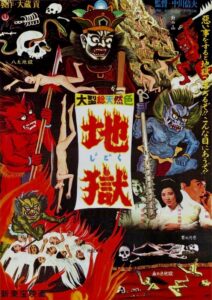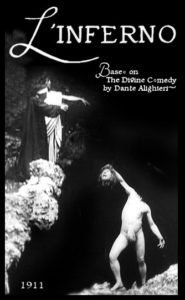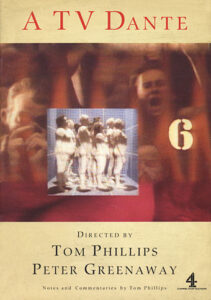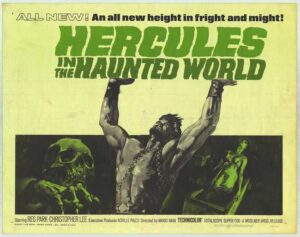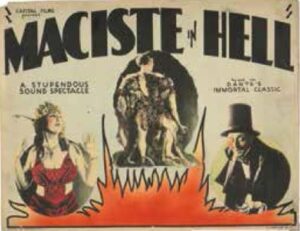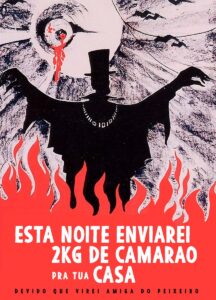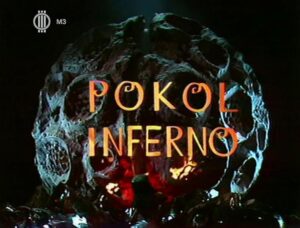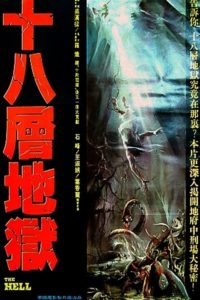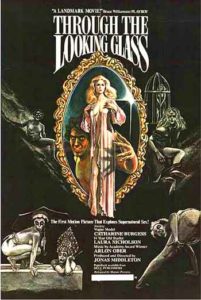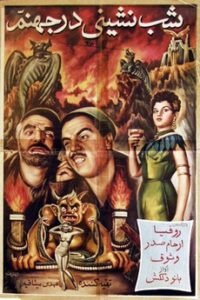Hell has been a staple of film literally since its earliest days. L’INFERNO, inspired by the “Inferno” portion of Dante Alighieri’s epic poem THE DIVINE COMEDY (1321), marked the premiere feature-length Italian film and the world’s first blockbuster. The silent era was especially receptive to the inferno onscreen, although, as we’ll see, plenty of full-color sound-era depictions of hell exist, showcasing a wealth of cultural interpretations.
What follows are my ten favorite hell-set movies. Many take that region as their major subject, while others use it as a last-minute stop-off. I’m not too partial to the latter trope (the reason films that utilize it, such as the 1924 DANTE’S INFERNO, THE BLACK HOLE and THE HOUSE THAT JACK BUILT, don’t generally make the list), although I did include a couple such examples below, simply because their respective depictions of Hades are so distinctive. So…
1. JIGOKU
This, I believe, is the finest cinematic depiction of the inferno. JIGOKU (1960) was the magnum opus of Nobuo Nakagawa, one of Japan’s premiere horrormeisters; his stunning widescreen compositions and absolute command of light and color make for a veritable feast for the eyes, even during the dull portions of the opening third.
JIGOKU (1960) Trailer
That timeframe is taken up with the misadventures of Shirô Shimiz (Shigeru Amachi), who after fooling around with a questionable “friend” finds himself involved in a number of “accidental” deaths. The outraged mother of one of Shirô’s victims eventually strangles him, consigning Shirô to the fiery realm. He—and we—travel through the many layers of this very Buddhist-minded inferno, containing a lake of excrement, a river of blood, a spiked terrain, flayed bodies, decapitations and so on. There’s never been another film quite like this one, although (as we’ll see) JIGOKU has been imitated. It was also remade twice, although neither version came close to replicating the skill and audacity of Nakagawa’s masterpiece.
2. L’INFERNO
As mentioned above, this is an Italian adaptation of Dante’s INFERNO, hailing from 1911. It follows the poem in extremely broad form, and lavishes equal attention on recreating the legendary DIVINE COMEDY etchings of Gustave Dore. We’re shown Dante (Salvatore Papa) guided by the poet Virgil (Arturo Pirovano) through Hell, where they witness tormented souls interned in fiery graves, buried alive, turned into trees, etc. At the end they see Lucifer (Augusto Milla), depicted as a winged creep ecstatically chewing on the bodies of sinners. The special effects are hopelessly primitive by today’s standards, but still do the job, and are often downright ingenious in their use of forced perspective and superimposition. The newly recorded score by Tangerine Dream annoyed at first but eventually grew on me, complementing the unruly visuals with restrained and subdued synthesizer tones.
3. A TV DANTE: THE INFERNO—CANTOS I-VIII
A positively mind-expanding piece of video making, co-directed by England’s always-idiosyncratic Peter Greenaway. This 1989 production may well be the decade’s most accomplished shot-on-video production (it was followed in 1991 by a far lesser Raul Ruiz helmed continuation), fully utilizing the medium’s many strengths. It helps, certainly, that the source material is (once again) Dante’s INFERNO. Greenaway and co-director Tom Phillips—who prepared an English translation of Dante’s poem that serves as narration—provide literal renditions of the inferno’s horrors, along with a sub-textual thesis on Dante’s background. The resulting video funhouse is a wonder to behold, with countless multi-layered images competing for our attention in a mix that’s darkly comical, repellant and never boring.
4. HERCULES IN THE HAUNTED WORLD
Italy’s Mario Bava was one of the screen’s pre-eminent visual stylists, and this was one of his most striking achievements. Filmed in eye-popping primary colors, HERCULES IN THE HAUNTED WORLD (Ercole al centro della Terra; 1961) is a psychedelic account of Hercules (Reg Park) and his journey through Hades to save his beloved from the clutches of the evil King Lico (Christopher Lee). The story is admittedly a jumble, but Bava’s hauntingly beautiful imagery, achieved through incredibly limited resources, is nothing short of astonishing. We see a stone monster, flying demons, zombies rising from their graves, a tightrope walk across a sea of bubbling lava and various other astonishing sights.
5. MACISTE IN HELL
Yet another Italian-made take on Dante (and one that plays like a dry-run for the above film). The hell depicted in this silent epic isn’t quite as distinctive as those of the above listings, as director Guido Brignone was clearly more interested in spectacle, sensation and Maciste (Bartolomeo Pagano), a beefy Italian cinema mainstay (and forerunner of Hercules), than the particulars of the inferno. Still, MACISTE IN HELL (Maciste all’inferno; 1925) contains some powerful imagery, including an impressive overhead shot of dozens of demons circling Maciste, a panoramic depiction of tortured souls baking on a boiling plain and the sight of a debauched inner chamber of the inferno, packed with scantily clad women, that horrified 1920s-era censors. The groundbreaking-for-their-time special effects remain startling, with early-stage Claymation and jump cuts utilized to strong effect; the sight of a headless man placing a severed head on his neck remains startling, even if the methodology is no longer novel.
6. THIS NIGHT I’LL POSSESS YOUR CORPSE
The second and (if you ask me) most striking film made by the late Brazilian madman Jose Mojica Marins (1936-2020), who created and incarnated the unforgettable character of Ze De Caxio, a.k.a. Coffin Joe. He wore a magician’s cloak and top hat, sported a bushy black beard and had fingernails that grew longer with each film. His mission: to spread evil and deliver an offspring into the world. In THIS NIGHT I’LL POSSESS YOUR CORPSE (Esta Noite Encarnarei no Teu Cadáver; 1967), as with its predecessor AT MIDNIGHT I’LL TAKE YOUR SOUL (À Meia Noite Levarei Sua Alma; 1963), those were his main concerns, expressed amid rambling speeches about the worthlessness of existence. Also featured is an abundance of graphic bloodletting and hallucinatory imagery, as well as (apropos to this article) a stunning Hell-set climax that, according to THE OVERLOOK FILM ENCYCLOPEDIA: HORROR, “leaves an impression of a very sick man’s home movies” and was re-used in at least two subsequent Marins films.
7. POKOL-INFERNO
The Hungarian TV ace András Rajnai (1934–2004) brought quite a few classic works of literature to the small screen, ranging from THE EPIC OF GILGAMESH to GULLIVER’S TRAVELS, and in this 56-minute telefilm he turned his gaze to Dante. A large part of the appeal of POKOL-INFERNO, and of all Rajnai’s literary adaptations, is their straightforwardness; in his films what you see is truly what you get, hidden meanings and intellectual subtext be damned. Yet if POKOL-INFERNO were at all known in the US (which to my knowledge it isn’t) it would probably be labeled avant-garde. Yes, Rajnai’s artistic choices often lean toward the experimental, such as the use of members of a Hungarian ballet troupe to represent the sinners of Hell, with torment conveyed through interpretive dances that are often superimposed, Maya Deren-like, over kaleidoscopic expanses. Equally odd are the scenery and special effects, accomplished with blue screen compositing that looks like something out of a Sid and Marty Croft 1970s kid show. There are, however, some amazing sights on display, such as a communal dance led by a giant hand, vertebral bones serving as an infernal staircase the principals ascend and a three-headed Lucifer whose painted faces closely resemble those of Mexican wrestlers.
8. THE HELL
This, it seems, was Taiwan’s answer to JIGOKU. As with that film, THE HELL (Shi ba ceng di yu; 1982) is quite graphic in its depiction of the tortures suffered by Hell’s denizens, and more overtly exploitive. Set in Feudal times, it features a swordsman whose sister is dragged off by Hell-spawned demons. The swordsman stays the night in a strange village that is in fact the portal to the underworld (the Buddhist inferno, FYI, has eighteen levels, at least fifteen of which appear to be missing from THE HELL), lorded over by the cat-faced Master Ghost. Upon descending into the inferno’s lower levels the swordsman, protected by a trio of rainbow-riding angels, sees people getting dissolved in acid, eaten by a giant snake, drawn and quartered, disemboweled and crushed. At just 75 minutes the whole thing feels a bit scant, but a fair amount of effort was clearly expanded by writer-director Chi Lo, as the elaborate set design and copious special effects are almost passable. The film was preceded, FYI, by another JIGOKU-inspired fantasy, TEN COURTS OF HADES (IN HELL/SHI DIAN YAN LUO; 1981), from the same director; THE HELL is better.
9. THROUGH THE LOOKING GLASS
One of the freakier 1970s porno features, and a singularly odd and striking piece of cinematic dementia. THROUGH THE LOOKING GLASS (1976) features a wealthy blond narcissist (Catharine Burgess) who enthusiastically masturbates in front of an attic mirror, which disgorges a scary (and extremely horny) personage who reveals some disquieting secrets about this woman’s life and deposits her in Hell. The semi-competent filmmaking, fully rounded narrative, jazzy score (by Alon Ober and future FRIDAY THE THIRTEENTH scorer Harry Manfredini) and decent (if not entirely “good”) performances result in one of the very few porno movies of the seventies (or indeed any period) that could conceivably play without the sex scenes. Then there’s the mind-roasting climax, set on a red-tinged mountainside packed with sex-crazed demons that, in the retinue of Southern California desert set infernos, far outdoes the one depicted in the overrated HIGHWAY TO HELL (1991).
10. A PARTY IN HELL
Not much of a movie, truth be told, but this Iranian fantasy is valuable as one of the cinema’s only depictions of Jahannam, the Islamic inferno. In A PARTY IN HELL (Shab-neshini dar Jahannam; 1956) that inferno takes the form of a Middle Eastern-flavored funhouse, run by an electronic devil’s head with flashing eyes, whose sights include a dance led by a nearly naked woman in which Nero, Napoleon Bonaparte, Genghis Khan and Adolph Hitler all make appearances. The film’s story, or what passes for one, concerns an impossibly greedy, misogynistic and plan evil man (Ezzatollah Vosoogh) who drops dead and, after meeting the Angel of Death, begins his journey to you-know-where.

